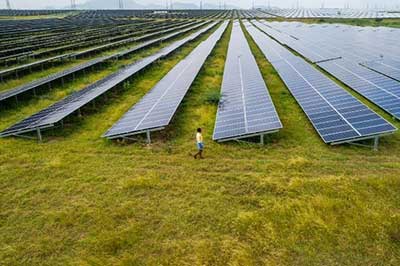Date: 02/02/2023
Relevance: GS-3: Infrastructure: Energy
Key Phrases: Solar energy, Central Electricity Authority, National Thermal Power Corporation Limited, particle (PM2.5) pollution, cost of carbon emission, Storage cost of solar energy.
Why in News?
- External pressure is pushing India more and more into the so-called carbon-limiting renewable energy path, along with a simple understanding that solar energy is a free gift from the sun, has encouraged over-reliance on solar energy in the country. But the solar energy is not the best option for India and it is better off just relying on large hydro and coal.
What are the Misconceptions?
- One argument put forth in favour of solar power is that the levelised cost of power is coming down and is close to that of coal. There are two flaws:
- Wrong comparison:
- The first flaw is the wrong comparison of solar power with coal electricity at the load centre, instead of at the pithed, which costs about half that of the load centre.
- According to the Central Electricity Authority, which was once the final arbiter in electricity matters, moving electricity through high voltage wires is cheaper than moving coal — and that is the reason for starting the National Thermal Power Corporation Limited (now NTPC Limited).
- Not comparing like with like:
- Solar electricity is intermittent and coal electricity is continuous. So, you have to add the cost of storage by battery.
- Protagonists of solar power will want us to add the environmental cost of carbon to coal — for its greenhouse gas emissions — but now the carbon market has crashed and is in that state for years; one does not have any objection to add its market price.
- The shadow price or true economic value of coal is even lower than its market price, since the cost of labour in mining carries a shadow price of zero (they being unskilled workers who would be unemployed otherwise).
Cost of production for solar and coal energy:
- Cost of carbon emission:
- Some enterprising researchers have quantified the cost of carbon emission in terms of deaths due to particle (PM2.5) pollution.
- Implicitly, they agree not to consider the greenhouse gases’ cost of coal, because it is a global issue, but want to include the particulate emission cost of carbon, which is a local issue.
- Here, the number of deaths is multiplied by a figure for the value of statistical life, calculated by asking potential victims “how much would you like to pay to avoid an increase in probability by 10% of your death due to pollution?”; they have arrived at a figure of ₹1 crore. The comparable figure in the United States is ₹1.8 crore.
- Nobody gets such high compensation. The victims of the Bhopal gas tragedy got a pittance compared to this figure.
- Taking this value of statistical life, they have adduced ₹1.64 per kwh of electricity to the carbon cost alone.
- Taken along with coal to load centre at a price of $44 per tonne and capital costs of coal plants at 8 cents to 12 cents per kwh for new power plants with low-capacity utilisation factor (which is never the case with coal, as they are operated nearer the base load with high plant load factors), coal-based electricity is categorically made unviable.
- Storage cost of solar energy:
- Solar energy is made financially viable by misguiding the people by leaving out storage battery cost; handicapping it with subsidies and concessions that are front loaded by the government, and forcing it on the industry and hapless discoms through state policy.
- That this is thrust down the throats of client discoms and industry is clear from the slow progress so far, the programme missing its target by 40%-50%, and discoms reneging on their 25-year power purchase agreements, on seeing lower and lower prices in later bids for others.
Potential in Hydropower:
- There seems to be competition, egged on by the West, between India and China, as to who does more renewable energy.
- We can do more renewable energy in large hydro, which is both low carbon and least cost.
- India has utilised only about 15% of its hydro potential whereas the U.S. and Europe have utilised 90% and 98% of their potential, respectively.
- The extent of utilisation of hydro potential seems to be an index of civilisational development and evolution.
- While China relies on renewable energy, it banks more on coal and hydro. The Three Gorges project on the Yangtze is the world’s biggest hydroelectric project.
- In India, powerful environmentalists stop large hydro projects in their tracks.
- One major reason for the sickness in the power sector is due to the focus on renewable energy in a big way.
Conclusion:
- India has a high potential in the solar energy sector, but there are also other cleaner options available that are also cost-effective.
- While India should continue to expand its economy on the back of renewable energy, the Government must take a hard look at whether renewable power, the solar, wind, or nuclear, meets standards of economic viability and environmental sustainability.
- Solar power may be a valuable tool in India’s energy transformation story, but it cannot be the panacea for every need.
- India should pay equal attention to other clean and reliable options, such as hydroelectric energy, to diversify its energy mix and reduce its over reliance on solar energy.
Source: The Hindu
Mains Question:
Q. “Solar power may be a valuable tool in India’s energy transformation story, but it cannot be the panacea for every need.” Critically analyse.







